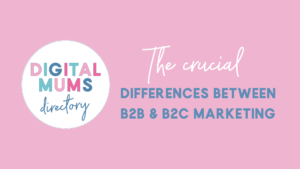 B2B and B2C marketing can be thought of as cousins: they share a level of DNA but are, effectively, two separate entities. Anyone responsible for any marketing element – be it for your own company or within an employed business framework – should be aware of the very distinct difference between the two.
B2B and B2C marketing can be thought of as cousins: they share a level of DNA but are, effectively, two separate entities. Anyone responsible for any marketing element – be it for your own company or within an employed business framework – should be aware of the very distinct difference between the two.
If we had to put this into a single sentence, it would be that:
B2B marketing involves logical, process-driven decisions, while B2C is more focused on emotional purchasing choices.
Despite this distinct difference, the basics of marketing are to develop relationships with customers that result in sales. The goal is the same, it’s just the path to get there that’s different.
B2B vs. B2C
To fully understand this, we need to break the process down into categories:
- Customer relationships
- Branding
- Terminology
- The decision-making process
- Finding your target audience
Customer relationships
This key difference can be defined as follows:
B2B marketing aims to create leads and build customer relationships to drive long-term business – in other words, it’s personal. This is very different from B2C marketing, which aims to direct the customer to the website to make a purchase using a purely online approach, therefore ‘costing’ the company as little time as possible to do so.
For example, a B2B marketer is likely to have personal contact (email/phone/in-person) with a potential customer. From generating leads through to the actual purchase, the intention is to continually strengthen the relationship between the two. In turn, this builds trust that increases the likelihood that they’ll continue to do business with you in the future
A B2C example doesn’t involve this direct communication. Instead, the objective is to drive the customer down a sales funnel to purchase as fast as possible. Personalisation is still achieved but in different ways, such as through reviews. Good products and good service equal good reviews. The tough part is to persuade the customer to do so – perhaps by offering an inventive (a discount on a future purchase, for instance) to take the time to write one.
Branding
B2B branding is more focused on positioning, showing potential customers your place in the market, company expertise and brand recognition. In turn, this helps generate leads that are so vital for this type of marketing.
B2C, on the other hand, is all about creating an emotional connection with the customer. This is vital, mainly because B2C marketing has minimal (if any) personal interaction. Therefore, branding has to deliver targeted notifications that not only motivates them to buy but delivers a message of trust, credibility and creates loyalty.
Terminology
Terminology is vital in B2B marketing. You must, Must, MUST, use the right words to solidify your place as a subject matter expert. Ads must be emotion-free and fact-driven, showing that what’s on offer is created by industry professionals for industry professionals. Fluffy copy has no place here.
Conversely, emotionally-driven ads underly the basis of B2C copy. While some industry-specific jargon might be relevant, more straightforward language is preferable – words that evoke the emotion that your product or service will bring.
The decision-making process
The B2B decision-making process follows a longer, meandering path than those that deal with the end consumer. Comms should be open and consist of both rational and emotional connections. Remember, B2B marketing is focused on the medium and long-term. Communication can be more protracted, allowing the business to realise the good fit that your company’s products offer.
In B2C, this process is far simpler. Identify a consumer need, tempt them with targeted advertising, show them how your product or service fulfils a need, build confidence and bingo! A sale is achieved. One vital aspect that influences this process is how easy your website is to navigate. Checkout should also be simple – many sales are lost due to a complex or difficult final purchasing process.
Finding your target audience
B2B normally works in niche markets. Know your product, understand your audience demographic, build a profile of your typical customer… Use all the tools at your disposal to do so, such as keyword research, Google Analytics and other online resources.
On the other hand, B2C marketers have a far wider audience. This makes driving the potential customer to the top of the sales funnel the primary objective. While this also involves analysing demographics, the initial sift will be from a much larger pool than is seen in B2B.
Guest Blog Post by Lorenza Minghetti of Zella DC
Lorenza is Zella DC’s Head of Corporate Communications. She holds a degree in Languages and a Masters Degree in Corporate Communications and Public Affairs. Originally from Italy, she has studied and developed her career in the UK and Australia. Lorenza has over 20 years’ experience in marketing, public relations and visual communication and has worked in a variety of roles, in agencies, in-house and as a freelancer.
